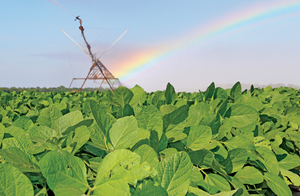
Going into the 2014 season, growers will have access to an “exciting” class of insecticides, says Angus Catchot, Mississippi State University Extension professor of entomology. "The diamides (Prevathon/Belt/Besiege) are “probably the most incredible chemistry my colleagues and I have ever seen on caterpillar pests. This chemistry is very selective, but very, very efficacious.”

ANGUS CATCHOT
And he said at the annual meeting of the Mississippi Agricultural Consultants Association, “It lasts a long, long time, with as much as 90 percent control after 32 days in bioassays— which is fantastic for growers and consultants. But from our standpoint, we have concern about the potential for development of resistance.”
Andrew Adams, a Ph.D. student, has been working on developing a baseline susceptibility model for the diamides, Catchot says. “This would provide us benchmark to compare back to in the event we start seeing control problems in the future.”
Some of the products in this class are known to be systemic when taken up through the roots, he notes. “We haven’t known whether it would move into the plant from foliar applications. We didn’t think it would, but we were curious to find out.
Ag news delivered daily to your inbox: Subscribe to Delta Farm Press Daily.
“We made a foliar application of 10 gallons per acre with hollow cone nozzles, just as we’d spray any other test. Soybeans were at about R-3. Then we watered them, waited, and pulled samples from the newest trifoliate that we knew positively hadn’t been treated.
“We conducted bioassays with corn earworm larvae and we found that, yes, there is apparently some systemic activity with foliar applications. Eleven days after treatment we were getting fantastic control systemically with Prevathon. We weren’t seeing that with Belt, which is in the same class of chemistry, but acts a bit differently.
“We repeated the test at 18 days and 25 days, and with Prevathon we were still seeing 90 percent control on new growth. That was pretty amazing. Even at 32 days, we were seeing 90 percent control.
“At 25 and 32 days, we did a residual check on leaves lower in the canopy that we knew had been sprayed. We bioassayed those tissues and all the diamide compounds, including Belt, were showing fantastic residual after 25 days.”
“I wouldn’t necessarily say because Prevathon is moving systemically that it will help with bollworm control. DuPont doesn’t think it will move into the fruiting structures, which is where bollworms feed.
Coverage is important
“So at the end of the day, coverage is still very important to provide adequate residual control. It is also important to note that, when these materials are normally applied, most of the vegetative growth of soybeans is over, so practically we are trying to figure out what this may mean.”
While he terms the diamide chemistry “incredible,” Catchot says, “We must be careful to protect it — the very long residual worries me.”
He says the first instance of diamide resistance in the entire U.S. has been documented in Mississippi in diamondback moths. “Before that, resistance in diamondback moths had only been found in the Philippines and Thailand. Although these moths are vegetable pests, these incidents make the point that this class of chemistry is not immune to resistance issues. We know it can happen, and we really need to be careful with our stewardship of these products.”
Last season, entomology specialists had “a lot of questions” about Intrepid Edge, Catchot says. “I felt this product had not been fully evaluated at the university level. On loopers, it looks good. There’s no super-long residual, but at 32 days it was still providing 64 percent control on corn earworm in our assays. It’s as good as anything out there for loopers, at the 4 oz. and 6 oz. rate, and data from Arkansas show it looks good on corn earworm as well.”
Diamond, an insect growth regulator, was also recently registered in soybeans, and has shown good results on stink bug nymphs, Catchot says.
“On southern green stink bug populations in Noxubee County, Miss., last year, we were averaging about 60 nymphs per 25 sweeps. At 6 days after treatment, it looked really good. At 13 days, there was a pretty good fall-off at the lower rates.
“Keep in mind that it will do really well on nymphs, but it won’t control adults, and it appears it will start breaking down after about 10 to 14 days on stink bugs. Then, you’ll have the adults to deal with.” There was also about 70 percent control of caterpillars.
Early planting soybean system
A “big project” on early-planted soybeans in the hills and Delta is continuing, Catchot says, and generating massive amounts of data.
“Eleven years ago, when I started work at Mississippi State University, about 65 percent to 70 percent of our beans were Group IVs that were planted before May 1st — and we weren’t spraying a lot of loopers.
“Now that cotton acreage has declined sharply, and we have a lot more corn and we’re planting a lot more beans behind wheat, we’re planting a lot more soybeans late. And we’re seeing a lot more caterpillar problems.
“I still contend that the early planting soybean system developed by Dr. Larry Heatherly is the best soybean pest management program we have. Those soybeans have always been the least affected by pests.”
The soybean project includes Group IV and Group V varieties with seven planting dates, starting in March and going into July in both the hills and the Delta, Catchot says.
“On top of those planting dates, we have four treatments: (1) Prevathon only, to try and simulate what the value of a Bt soybean might be for Mississippi producers; this includes automatic 14 oz. applications of Prevathon alone every couple of weeks; (2) a threshold level treatment, (3) an untreated check, and (4) a disruptive treatment — an automatic insecticide application at R-3.”
The Prevathon/Bt simulation came out on top, threshold was second, untreated was third, and automatic disruptive spray came in last.
“The point of this,” Catchot says, “is that if you don’t have bugs in the field, you can make a problem that can actually hurt you, that will penalize you on yield, by spraying when pests are not there. “
A graduate student, Brian Adams, has been doing work to reevaluate insect thresholds in soybeans, he says.
Findings are still preliminary, “but one of the things the data are suggesting is that there’s a lot more compensation for corn earworm damage in soybean plants than we previously thought. We’ve seen as much as 50 percent damage to plants in early growth stages, with very little yield loss.
“This is ongoing, but we working hard to reevaluate all our thresholds in soybeans under today’s management systems.”
About the Author(s)
You May Also Like




